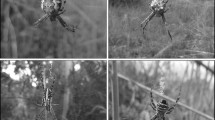Abstract
Orb-weaving spiders construct webs with adhesive silk but are not trapped by it. Previous studies have attributed this defense to an oily coating on their legs that protects against adhesion or, more recently, to behavioral avoidance of sticky lines. The old evidence is very weak, however, and the behavioral avoidance explanation is inadequate because orb-weavers push with their hind legs against sticky lines hundreds or thousands of times during construction of each orb and are not trapped. Video analyses of behavior and experimental observations of isolated legs pulling away from contact with sticky lines showed that the spider uses three anti-adhesion traits: dense arrays of branched setae on the legs that reduce the area of contact with adhesive material; careful engagement and withdrawal movements of its legs that minimize contact with the adhesive and that avoid pulling against the line itself; and a chemical coating or surface layer that reduces adhesion.


Similar content being viewed by others
References
Agnarsson I, Blackledge T (2009) Can a spider web be too sticky? Tensile mechanics constrains the evolution of capture spiral stickiness in orb-weaving spiders. J Zool 278:134–140
Bush WM, Hu DL, Prakash M (2008) The integument of water-walking arthropods: form and function. Adv Ins Physiol 34:118–192
Craig C (2003) Spider webs and silk. Oxford University Press, New York
Dean J, Smith A (1978) Behavioral and morphological adaptations of a tropical plant to high rainfall. Biotropica 102:152–154
Denny M (1976) The physical properties of spider's silk and their role in the design of orb-webs. J Exp Biol 65:483–506
Eberhard W (1982) Behavioral characters for the higher classification of orb-weaving spiders. Evolution 36:1067–1095
Fabre J (1912) The life of the spider (trans: Teixeira de Mattos A). Blue Ribbon Books, New York
Foelix R (1996) The biology of spiders. Harvard University Press, Cambridge
Hingston R (1920) A naturalist in Himalya. Small, Maynard & Co., Boston
Hingston R (1922) The snare of the giant wood spider (Nephila maculata). J Bombay Nat Hist Soc 28:642–649
Kropf C, Bauer D, Schläppi T, Jacob A (2012) An organic coating keeps orb-weaving spiders (Araneae, Araneoidea, Araneidae) from sticking to their own capture threads. J Zool Syst Evol Res 50:14–18
Lubin Y (1973) Web structure and function: the non-adhesive orb-web of Cyrtophora moluccensis (Doleschall) (Araneae: Araneidae). Forma Funct 6:337–358
Opell B, Hendricks M (2007) Adhesive recruitment by the viscous capture threads of araneoid orb-weaving spiders. J Exp Biol 210:553–560
Opell B, Hendricks M (2010) The role of granules within viscous capture threads of orb-weaving spiders. J Exp Biol 213:339–346
Peters H (1954) Estudios adicionales sobre la estructura de la red concéntrica de las arañas. Comun Inst Trop Invest Cient 3:1–18
Sahni V, Blackledge T, Dhinojwala A (2010) Viscoelastic solids explain spider web stickiness. Nat Comm 1–4:19. doi:10.1038/ncomms1019
Vollrath F, Tillinghast E (1991) Glycoprotein glue beneath a spider web’s aqueous coat. Naturwissenschaften 78:557–559
Wiehle H (1927) Z. Beitrage zur Kenntnis des Radnetzbaues der Epeiriden, Tetragnathiden, und Uloboriden. Morphol Oekol Tiere 9:418–537
Acknowledgments
We thank Brent Opell, Julio Mata, Mavis Montero, and Jerome Rovner for advice; Diego Gonzalez-Florez for permission to cite unpublished observations; personnel of the Parque Braulio Carillo; and the Smithsonian Tropical Research Institute and the Universidad de Costa Rica for financial support.
Author information
Authors and Affiliations
Corresponding author
Additional information
Communicated by: Sven Thatje
Electronic supplementary materials
Below is the link to the electronic supplementary material.
(MPG 12698 kb)
(MPG 9904 kb)
(MPG 4106 kb)
Rights and permissions
About this article
Cite this article
Briceño, R.D., Eberhard, W.G. Spiders avoid sticking to their webs: clever leg movements, branched drip-tip setae, and anti-adhesive surfaces. Naturwissenschaften 99, 337–341 (2012). https://doi.org/10.1007/s00114-012-0901-9
Received:
Revised:
Accepted:
Published:
Issue Date:
DOI: https://doi.org/10.1007/s00114-012-0901-9




